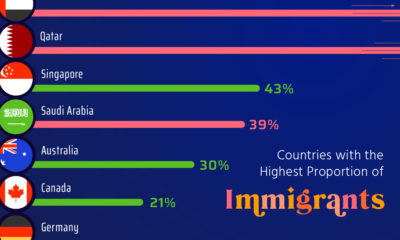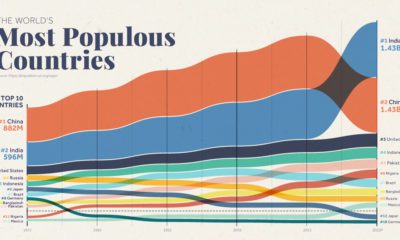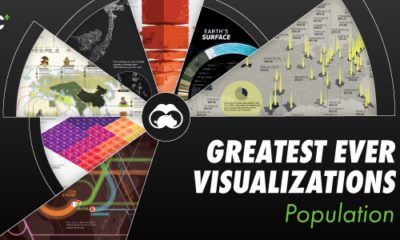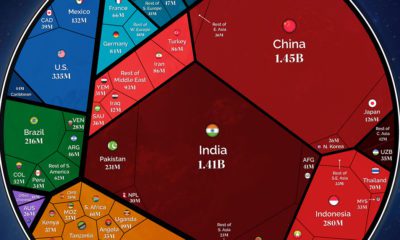Not only are they all world-class cities that still serve as global hubs of commerce, but these cities also share a relatively rare and important historical designation. At specific points in history, each of these cities outranked all others on the planet in terms of population, granting them the exclusive title as the single most populated city globally.
Ranking the World’s Most Populous Cities
Today’s animation comes to us from John Burn-Murdoch with the Financial Times, and it visualizes cities ranked by population in a bar chart race over the course of a 500-year timeframe. Beijing starts in the lead in the year 1500, with a population of 672,000: In the 16th century, which is where the animation starts, cities in China and India were dominant in terms of population. In China, the cities of Beijing, Hangzhou, Guangzhou, and Nanjing all made the top 10 list, while India itself held two of the most populous cities at the time, Vijayanagar and Gauda. If the latter two names sound unfamiliar, that’s because they were key historical locations in the Vijayanagara and Bengal Empires respectively, but neither are the sites of modern-day cities.
The 1 Million Mark
For the first minute of animation—and up until the late 18th century—not a single city was able to eclipse the 1 million person mark. However, thanks to the Industrial Revolution, the floodgates opened up. With more efficient agricultural practices, better sanitation, and other technological improvements, cities were able to support bigger populations. Here’s a look at the biggest cities in the year 1895: In the span of roughly a century, all of the world’s biggest cities were able to pass the 1 million mark, making it no longer a particularly exclusive milestone.
Modern City Populations
Finally, let’s look at the modern list of the top 10 most populous cities, and see how it compares to rankings from previous years: Interestingly, the modern list appears to be a blend of both previous rankings from the years 1500 and 1895, listed above. In 2018, cities from China and India feature prominently, but New York City and Tokyo are also included. Meanwhile, Latin America has entered the fold with entries from Mexico and Brazil.
The Future of Megacities
If you think the modern list of the most populous cities is impressive, check out how the world’s megacities are expected to develop as we move towards the end of the 21st century. on Even while political regimes across these countries have changed over time, they’ve largely followed a few different types of governance. Today, every country can ultimately be classified into just nine broad forms of government systems. This map by Truman Du uses information from Wikipedia to map the government systems that rule the world today.
Countries By Type of Government
It’s important to note that this map charts government systems according to each country’s legal framework. Many countries have constitutions stating their de jure or legally recognized system of government, but their de facto or realized form of governance may be quite different. Here is a list of the stated government system of UN member states and observers as of January 2023: Let’s take a closer look at some of these systems.
Monarchies
Brought back into the spotlight after the death of Queen Elizabeth II of England in September 2022, this form of government has a single ruler. They carry titles from king and queen to sultan or emperor, and their government systems can be further divided into three modern types: constitutional, semi-constitutional, and absolute. A constitutional monarchy sees the monarch act as head of state within the parameters of a constitution, giving them little to no real power. For example, King Charles III is the head of 15 Commonwealth nations including Canada and Australia. However, each has their own head of government. On the other hand, a semi-constitutional monarchy lets the monarch or ruling royal family retain substantial political powers, as is the case in Jordan and Morocco. However, their monarchs still rule the country according to a democratic constitution and in concert with other institutions. Finally, an absolute monarchy is most like the monarchies of old, where the ruler has full power over governance, with modern examples including Saudi Arabia and Vatican City.
Republics
Unlike monarchies, the people hold the power in a republic government system, directly electing representatives to form government. Again, there are multiple types of modern republic governments: presidential, semi-presidential, and parliamentary. The presidential republic could be considered a direct progression from monarchies. This system has a strong and independent chief executive with extensive powers when it comes to domestic affairs and foreign policy. An example of this is the United States, where the President is both the head of state and the head of government. In a semi-presidential republic, the president is the head of state and has some executive powers that are independent of the legislature. However, the prime minister (or chancellor or equivalent title) is the head of government, responsible to the legislature along with the cabinet. Russia is a classic example of this type of government. The last type of republic system is parliamentary. In this system, the president is a figurehead, while the head of government holds real power and is validated by and accountable to the parliament. This type of system can be seen in Germany, Italy, and India and is akin to constitutional monarchies. It’s also important to point out that some parliamentary republic systems operate slightly differently. For example in South Africa, the president is both the head of state and government, but is elected directly by the legislature. This leaves them (and their ministries) potentially subject to parliamentary confidence.
One-Party State
Many of the systems above involve multiple political parties vying to rule and govern their respective countries. In a one-party state, also called a single-party state or single-party system, only one political party has the right to form government. All other political parties are either outlawed or only allowed limited participation in elections. In this system, a country’s head of state and head of government can be executive or ceremonial but political power is constitutionally linked to a single political movement. China is the most well-known example of this government system, with the General Secretary of the Communist Party of China ruling as the de facto leader since 1989.
Provisional
The final form of government is a provisional government formed as an interim or transitional government. In this system, an emergency governmental body is created to manage political transitions after the collapse of a government, or when a new state is formed. Often these evolve into fully constitutionalized systems, but sometimes they hold power for longer than expected. Some examples of countries that are considered provisional include Libya, Burkina Faso, and Chad.













